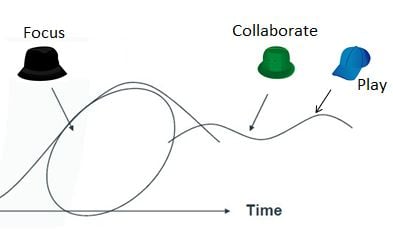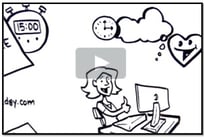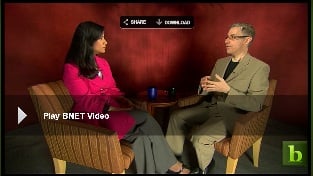 For years, my friend and fellow entrepreneur Dave McClure used the expression "500 Hats" (which became his personal and professional brand) to refer to the many hats entrepreneurs wear as they get a new startup off the ground. Dave did an outstanding job at wearing these hats and he recently went on to start a new seed fund & incubator program called 500 Startups in which Dave offers advising and investing.
For years, my friend and fellow entrepreneur Dave McClure used the expression "500 Hats" (which became his personal and professional brand) to refer to the many hats entrepreneurs wear as they get a new startup off the ground. Dave did an outstanding job at wearing these hats and he recently went on to start a new seed fund & incubator program called 500 Startups in which Dave offers advising and investing.
While a few “super” entrepreneurs like Dave McClure and Mark Zuckerberg might enjoy, and even thrive, wearing the 500 Hats, the rest of us are likely to be happier and more effective with far fewer hats. Yet today's workplace, and our own self-inflicted work habits, seem to continuously gravitate us towards wearing too many hats and leaving us more often than not stranded in a world of utter chaos or at best with less-than-optimum performance, and not to mention stress and dissatisfaction.
So let me "simplify!" Are you ready to meet the 5 Hats?
The 5 Hats of Highly Accomplished People
If you have downloaded my free eBook titled the Results Curve: How to Manage Focused and Collaborative Time, you already have a head start in putting these 5 Hats into practice. If not, I invite you to do so to get the full picture and the underlying concepts as well as the specific techniques that will help you stick to these new habits and turn them into natural behaviors.
Hat #1: The Focus Hat
 Put on your Focus Hat and dive deep into an important task that is going to make a difference. Meaningful accomplishments don't come from working a few minutes here and a few minutes there. Meaningful accomplishments require focused and purposeful effort. When you are working in few minutes increments, or even seconds nowadays, you may be getting things done and getting some immediate gratification, but hardly thinking strategically and creatively, and rarely solving important and complex problems.
Put on your Focus Hat and dive deep into an important task that is going to make a difference. Meaningful accomplishments don't come from working a few minutes here and a few minutes there. Meaningful accomplishments require focused and purposeful effort. When you are working in few minutes increments, or even seconds nowadays, you may be getting things done and getting some immediate gratification, but hardly thinking strategically and creatively, and rarely solving important and complex problems.
Depending on the task on hand, keep the Focus Hat on until you have made significant progress. For some tasks, this may be 10 or 15 minutes, while for others, it may be 30 or 45 minutes, or even longer. The Results Curve suggests 40 minutes as the limit and then switching hats for at least a bit before coming back to the Focus Hat.
Hat #2: The Collaboration Hat
After your focused session, take off your Focus Hat and put on your Collaboration Hat. This means check e-mail, voice mail, talk to people, ask for what you need, give others what they need, and be fully collaborative. This is fast paced, total multi-tasking, and utter engagement. With the Collaboration Hat on, go as fast as you want and can, un-limit yourself, and multi-task to your heart’s desire. After all, we live in a highly interdependent and fast-paced work environment. Oh, and don’t forget to check the social networks.
Collaboration is key and therefore the Collaboration Hat is absolutely necessary. And while we hear so many messages about multi-tasking being a problem, Dawna Ballard, Ph.D., Associate Professor of Communication Studies at the University of Texas, Austin, confirmed at our lunch and learn webinars a couple of week ago that multi-tasking is not in and by itself the problem. It is only a problem when we “only” multi-task. In other words when instead of wearing the Collaboration Hat, we get stuck with a Collaboration Shirt at all times.
Hat #3: The Play Hat
Take off your Collaboration Hat and go wild (with a little obvious disclaimer here about staying professionally and socially responsible). The concept of play in the workplace continues to be worrisome for some. However research is proving time after time that environments that tolerate or even encourage play are thriving with engagement, innovation, and productivity. Chuck Hamilton, Manager at the IBM Center for Advanced Learning, talked about the IBM@PLAY program at our lunch & learn webinars last year. Chuck discussed how playful tools and projects are spreading across their workplace including the use of Virtual Worlds to help connect people globally across the organization.
Play means different things to different people. I would like to define it as being whatever activity gets you refreshed, energized, and fully engaged. It is intended to help you avoid heading downhill on the Results Curve into the darkness of boredom and inefficiency. Play can mean getting physically active and engaging in a play activity on one end of the spectrum, to having a few minutes of silence and letting the mind wander on the other end of the spectrum. Stay tuned for more discussions of play activities and for the “playtime challenge” that is coming soon!
Hat #4: The E-mail Hat
Take off the e-mail “shirt” that you are wearing all the time (you know what happens when you wear the same thing all the time) and put on the E-mail Hat. This means don’t treat e-mail like an on-going activity that you do all day long. Last time I checked, e-mail was not part of your job description and you are not being paid to just do e-mail. So I suggest a mind shift: “E-mail is a task, and like any other task, it needs to have a clear beginning and a clear end.” So put the E-mail Hat on and work on this e-mail task—fearlessly and fiercely processing the new messages in your inbox. Then you take your E-mail Hat off and now stay off e-mail until after you gave focus, collaboration, and play the time their deserve.
Similar to what Dawna Ballard, Ph.D., said about multi-tasking, I extrapolate this to e-mail: E-mail is not the problem, the problem is that we do e-mail all the time. For more details and to view a demo of how to simplify the e-mail task, visit my previous article “Tip-Of-The-Month: How to manage the e-mail overload, part 2 of many.”
Jared Goralnick (Founder of Awayfind.com) and I share a vision in which we want to enable business professionals completely change the way they do e-mail and break free from the e-mail jail. Stay tuned for more information about how to setup automatic notifications based on smart filters so that important messages are relayed to you instead of you having to watch for them on e-mail.
Hat #5: The Light-Focus Hat
While the Focus Hat is critical for the important and strategic tasks that require in-depth thinking, a myriad of other tasks can be handled while still being able to keep an eye and respond to incoming inquiries. The Light-Focus Hat is exactly that--working on our own tasks while still being open to handling incoming inquiries. Put this hat on when you are able and willing to stop the task on hand, handle a request, and then resume your original task.
The Results Curve Hats
If you have seen the Results Curve, you may enjoy its new look with the key hats I described above:

By the way Dave McClure actually wore a variety of "chapeau" while playing ultimate frisbee around the SF bay area. So don't by shy. Get real hats and make use of them to make a point to yourself first and to your community second! I got my Focus Hat (the one displayed above) and now shopping for my E-mail Hat!
Download the Results Curve for a more thorough examination of our work habits today and how to better manage focused and collaborative time!
Get The Accomplishing More With Less Workbook to get the full picture! See reviews at Amazon.com
 This is one of the questions that Dr. Alicia Ruelaz asks in her book Is It ADHD or My iPhone? I am reading it right now, and finding it so insightful and applicable to today's modern life. I am also excited about having Dr. Ruelaz present at our lunch & learn webinar next week (Overcome ADD Symptoms to Achieve Breakthrough Productivity , on May 19), where she will tackle this issue and many others and give us some practical advice on how to overcome the symptoms.
This is one of the questions that Dr. Alicia Ruelaz asks in her book Is It ADHD or My iPhone? I am reading it right now, and finding it so insightful and applicable to today's modern life. I am also excited about having Dr. Ruelaz present at our lunch & learn webinar next week (Overcome ADD Symptoms to Achieve Breakthrough Productivity , on May 19), where she will tackle this issue and many others and give us some practical advice on how to overcome the symptoms.







 As the deadline approaches for completing the manuscript for the Accomplishing More With Google Apps book, I needed to take some drastic measures to stay on track. One of them was to take two whole days out of my busy schedule and work uninterrupted on writing and editing.
As the deadline approaches for completing the manuscript for the Accomplishing More With Google Apps book, I needed to take some drastic measures to stay on track. One of them was to take two whole days out of my busy schedule and work uninterrupted on writing and editing. I belong to this organization (its name to remain anonymous) and it was time to renew my membership recently. I was asked to fill out the membership application again (same application that we filled out last year). Being the productivity and efficiency evangelist that I am, I couldn’t “digest” that request very well. So I objected and questioned why we would be asked to submit the same information again! Shouldn’t we all be focused on doing work that has some purpose after all?
I belong to this organization (its name to remain anonymous) and it was time to renew my membership recently. I was asked to fill out the membership application again (same application that we filled out last year). Being the productivity and efficiency evangelist that I am, I couldn’t “digest” that request very well. So I objected and questioned why we would be asked to submit the same information again! Shouldn’t we all be focused on doing work that has some purpose after all? Last week,
Last week,  For years, my friend and fellow entrepreneur Dave McClure used the expression "500 Hats" (which became his personal and professional brand) to refer to the many hats entrepreneurs wear as they get a new startup off the ground. Dave did an outstanding job at wearing these hats and he recently went on to start a new seed fund & incubator program called
For years, my friend and fellow entrepreneur Dave McClure used the expression "500 Hats" (which became his personal and professional brand) to refer to the many hats entrepreneurs wear as they get a new startup off the ground. Dave did an outstanding job at wearing these hats and he recently went on to start a new seed fund & incubator program called  Put on your Focus Hat and dive deep into an important task that is going to make a difference. Meaningful accomplishments don't come from working a few minutes here and a few minutes there. Meaningful accomplishments require focused and purposeful effort. When you are working in few minutes increments, or even seconds nowadays, you may be getting things done and getting some immediate gratification, but hardly thinking strategically and creatively, and rarely solving important and complex problems.
Put on your Focus Hat and dive deep into an important task that is going to make a difference. Meaningful accomplishments don't come from working a few minutes here and a few minutes there. Meaningful accomplishments require focused and purposeful effort. When you are working in few minutes increments, or even seconds nowadays, you may be getting things done and getting some immediate gratification, but hardly thinking strategically and creatively, and rarely solving important and complex problems. 
 If you have been part of our community and participated in our
If you have been part of our community and participated in our  The setting was one of the
The setting was one of the  Julie & Jenny, both very active and in leadership roles at their company and both having to deal with loads of e-mail messages constantly pouring into their inboxes, get together regularly not just to have friendly chats, but for something more drastic which they refer to as an e-mail "party"! Basically it is a get-together that is focused on processing their e-mail messages, however after creating the right atmosphere to make this a fun activity. "Fun?" You might ask. Well, keep on reading.
Julie & Jenny, both very active and in leadership roles at their company and both having to deal with loads of e-mail messages constantly pouring into their inboxes, get together regularly not just to have friendly chats, but for something more drastic which they refer to as an e-mail "party"! Basically it is a get-together that is focused on processing their e-mail messages, however after creating the right atmosphere to make this a fun activity. "Fun?" You might ask. Well, keep on reading. My friend Liz said that she realized after a while that no matter how hard she tries to resist having the variety of chocolate treats that are nicely distributed throughout her home, she kept falling for the temptation and having them! What eventually worked for her is to not have chocolate around--in other words, a chocolate-free home! Without getting too deep into the psychological aspects of addictions, let us just keep things simple for now, and extrapolate this techniques to see how it might help with resisting daily interruptions and distractions that keep us getting off track and away from our important initiatives and projects.
My friend Liz said that she realized after a while that no matter how hard she tries to resist having the variety of chocolate treats that are nicely distributed throughout her home, she kept falling for the temptation and having them! What eventually worked for her is to not have chocolate around--in other words, a chocolate-free home! Without getting too deep into the psychological aspects of addictions, let us just keep things simple for now, and extrapolate this techniques to see how it might help with resisting daily interruptions and distractions that keep us getting off track and away from our important initiatives and projects.
